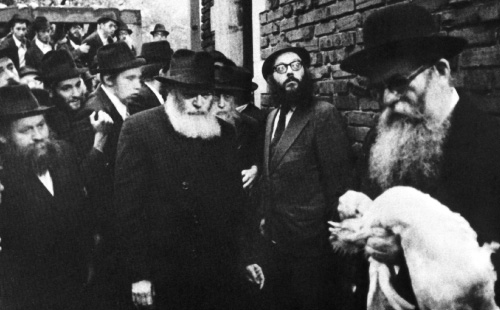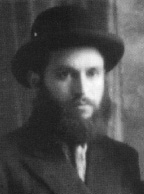THE REBBE’S SHOCHET
Every Erev Yom Kippur he could be seen standing in the yard of 770, ready to receive the Rebbe’s Kaparos chicken for shechting. He also prepared the Rebbe’s Pesach wine. * Profile of the recently departed Rabbi Yisroel Shimon Kalmanson a”h.
 Shechting the Rebbe’s Kaparos in the 70’s
Shechting the Rebbe’s Kaparos in the 70’s
The shochet Rabbi Yisroel Shimon Kalmanson a”h was born in Vitebsk on 15 Shevat 5674/1914 to his parents, Rabbi Shneur Zalman and Menucha Kalmanson. When he was a child, the family moved to Pushkina, a suburb of Leningrad, where a Chabad k’hilla was beginning to develop. He was twelve years old when he started learning in underground Tomchei T’mimim yeshivos. Due to communist persecution, he had to wander from city to city with his friends. In each place they stopped, they opened new branches of the underground yeshiva.
He spoke about this period of his life:
 Rabbi Yisroel Shimon Kalmanson“I went to learn in Nevel in the winter of 5686/1926. I went home for Pesach. When I returned to yeshiva, we – a class of six bachurim – went with Rabbi Avrohom (Maiyor) Drizin to open a new branch in Polotsk, where we learned throughout the summer of 5686 and the winter of 5687.”
Rabbi Yisroel Shimon Kalmanson“I went to learn in Nevel in the winter of 5686/1926. I went home for Pesach. When I returned to yeshiva, we – a class of six bachurim – went with Rabbi Avrohom (Maiyor) Drizin to open a new branch in Polotsk, where we learned throughout the summer of 5686 and the winter of 5687.”
He celebrated his bar mitzva away from home, in yeshiva in Polotsk. Rabbi Drizin taught him the bar mitzva maamer.
“After Pesach 5687, Rabbi Drizin went with us to open a new yeshiva in Vitebsk. At the end of the summer 5688, I returned to Polotsk. We learned there until the end of the winter 5689. That is when they arrested the mashpia Rabbi Shlomo Chaim Kesselman and expelled the students. Rabbi Shlomo Chaim was expelled to Poltava and was forbidden to return to Polotsk.” (Toldos Chabad B’Russia p. 274)
When the yeshiva was closed in Polotsk, Rabbi Yisroel Shimon and his friends went to learn in Charson. From there they went to Odessa, where they learned throughout the year 5690. At the beginning of 5691 they returned to Vitebsk. From there he went to Leningrad at the end of the winter 5691 as he related:
“A small group of older bachurim went to Leningrad [from Vitebsk, at the end of winter 5691] where we learned during the summer 5691 and the winter 5692. Then the Rebbe Rayatz, who was in Riga, told us to find work and to try to leave Russia.” (Ibid p. 282)
That is what his youth consisted of: wandering from place to place with a lack of serenity, but Torah and Chassidus filled his days and life despite it all.
His wanderings ended at this point. When he became of marriageable age, his shidduch came from distant parts as follows:
The wedding of Rabbi Shmuel, the son of Rabbi Elchanan Morosov, the secretary of the Rebbe Rayatz, took place in Leningrad. The kalla, Sheindel, who was the daughter of Rabbi Moshe Geisinsky, shochet in Krivorog, came with her family to the wedding. The opportunity arose, and her sister Chaya Sarah was suggested as a shidduch for Rabbi Yisroel Shimon.
In a letter from the Rebbe Rayatz, apparently addressed to R’ Yisroel Shimon’s father, the Rebbe writes his consent and blessings for the shidduch: “The suggestion for your son Rabbi Yisroel Shimon is proper and may it be concluded in a good and auspicious time, materially and spiritually …” (Igros Kodesh vol. 11 letter #4103)
The wedding took place on 10 Kislev 5696 at the Raskin home and the simcha went on all night. The young couple lived near his parents in Pushkina.
WANDERING AND ESCAPE
During World War II, Rabbi Kalmanson fled the war zone together with his father’s family, his brother, his brother-in-law Rabbi Berke Chein, the family of Rabbi Avrohom Eliyahu Plotkin, the family of Rabbi Shmuel Menachem Klein, and others. Together, they were miraculously able to reach a distant place, a kolkhoz (farming collective) by the name of Bortyok, where they lived for two years without knowing how the war was progressing.
Then one day, the Kalmansons received a letter from a relative describing the destruction in Leningrad, the city from where they had escaped. “It is all S’dom and Amora. There is no food and people are dropping in the street from starvation. The houses in the neighborhood you lived in are destroyed and many residents were killed by bombs.”
They had mixed feelings about the letter. On the one hand, they were grateful to have escaped the city at the last moment. On the other hand, they were distraught over the many that had died, including Lubavitcher Chassidim whom they knew.
After two years in Bortyok, they heard that in Tashkent and Samarkand many Chassidim had gathered and had formed k’hillos. They traveled together to Uzbekistan with some of them settling in Tashkent, and Rabbi Yisroel Shimon and his family settling in Samarkand. After the war, Rabbi Yisroel Shimon and his friend Rabbi Mordechai Schusterman traveled to Lvov to smuggle across the border.
Rabbi Yisroel Shimon had a Polish passport that he had bought for a steep price. He was supposed to attach his picture to the new passport, but this would cost 500 rubles and he had no more money. He hoped he would be able to use this passport without his picture in it.
He, Rabbi Mordechai and their families went to Moscow and from there to Lvov. There they learned that there must be a recent picture of the bearer of the passport. Rabbi Mordechai, using primitive tools, stuck in the picture and next to it used a counterfeit seal of the Samarkand police that supposedly approved the picture. On 15 Av 1946, the two families boarded the train and after several hours were in Poland, to their tremendous joy and relief.
From Poland they went to Germany where they lived temporarily in the famous DP camp in Poking. That is where he studied sh’chita and received “kabbala” from Rabbi Avrohom Eliyahu Plotkin and Rabbi Mendel Dubroskin.
The Chabad Chassidim wondered where to go from there, whether to Eretz Yisroel, to the United States, or other countries. Rabbi Yisroel Shimon was one of the first to receive the Rebbe Rayatz’s instruction to move to New York.
APPOINTING THE REBBE
He arrived in New York in Cheshvan 5709. He spoke to the Rebbe’s son-in-law, Ramash, who inquired about those still in the DP camps. Rabbi Yisroel Shimon told about the hardships experienced by those who had made aliya at that time, and Ramash told him to speak to the Rebbe Rayatz and ask him what the Chassidim should do, i.e. should they move to Eretz Yisroel or the United States.
Rabbi Yisroel Shimon had yechidus with the Rebbe Rayatz who told him that although generally, it was not the practice to ask a second time (at that time, the general instruction was to make aliya), but since the situation had changed, each one should ask his own question and would receive a personal response about what to do.
This answer was conveyed to the DP camps and many wrote to the Rebbe Rayatz, asking what they should do. Some were told to go to Eretz Yisroel and others were told to immigrate to the United States.
After the passing of the Rebbe Rayatz, Rabbi Kalmanson was completely mekushar to the Rebbe and during the period of the Kabbalas HaNesius, he was one of the few Chassidim who accompanied Rabbi Yerachmiel Benjaminson, one of the elder Chassidim, who read a pidyon nefesh at the Rebbe’s gravesite that Ramash should be willing to accept the Chabad leadership.
EREV YOM KIPPUR TASKS
In 5714, Rabbi Kalmanson was appointed as the shochet who would shecht the Rebbe’s Kaparos chicken. For the next forty years, every Erev Yom Kippur, the Rebbe gave him the chicken, which he proceeded to slaughter in the Rebbe’s presence. The Rebbe performed the mitzva of covering the blood.
There were also things that Rabbi Kalmanson did far from the public eye. First of all, since he was the one who shechted the Kaparos, he always had yechidus afterward. In this yechidus, the Rebbe would speak to him about sh’chita in general as well as about Lubavitch sh’chita. In later years, the Rebbe tried to dissuade him from retiring from sh’chita. In these private audiences, he also received personal brachos for himself and his family.
For more than twenty years, following the passing of Rabbi Yochanan Gordon, he was the one who gave malkus (symbolic lashes) to the Rebbe on Erev Yom Kippur. Naturally, he was reluctant to fill this role, but the Rebbe told him to do it since the sh’chita was dependent on the malkus; if he did not give malkus, he would not be allowed to shecht. Rabbi Kalmanson did not want to give up the privilege of shechting, so he took on the role of giving malkus to the Rebbe every Erev Yom Kippur.
For many years, Rabbi Kalmanson made wine for the Rebbe for Pesach. The Rebbe paid him for this every year.
In 5721, when his mother along with her daughter Feigel and her son-in-law Reb Berke left Russia, he asked the Rebbe for permission to go to Eretz Yisroel to see them. The Rebbe asked him whether the wine for Pesach was already prepared and when he said it was, the Rebbe gave him a bracha for the trip.
SMICHA TO HUNDREDS
Over the years, he taught sh’chita in the Crown Heights kollel and in 770. He conveyed his knowledge and professionalism, as well as the concept of “Lubavitcher sh’chita,” and gave smicha to hundreds of young men.
In recent years he was in poor health. He passed away on 30 Shevat at the age of 98. He is survived by his son Rabbi Sholom Dovber, shliach in Cincinnati, Rabbi Mordechai of New York, Mrs. Rochel Heber of New York, and Mrs. Miriam Blizinsky of New York.
 May 3, 2012
May 3, 2012
Reader Comments